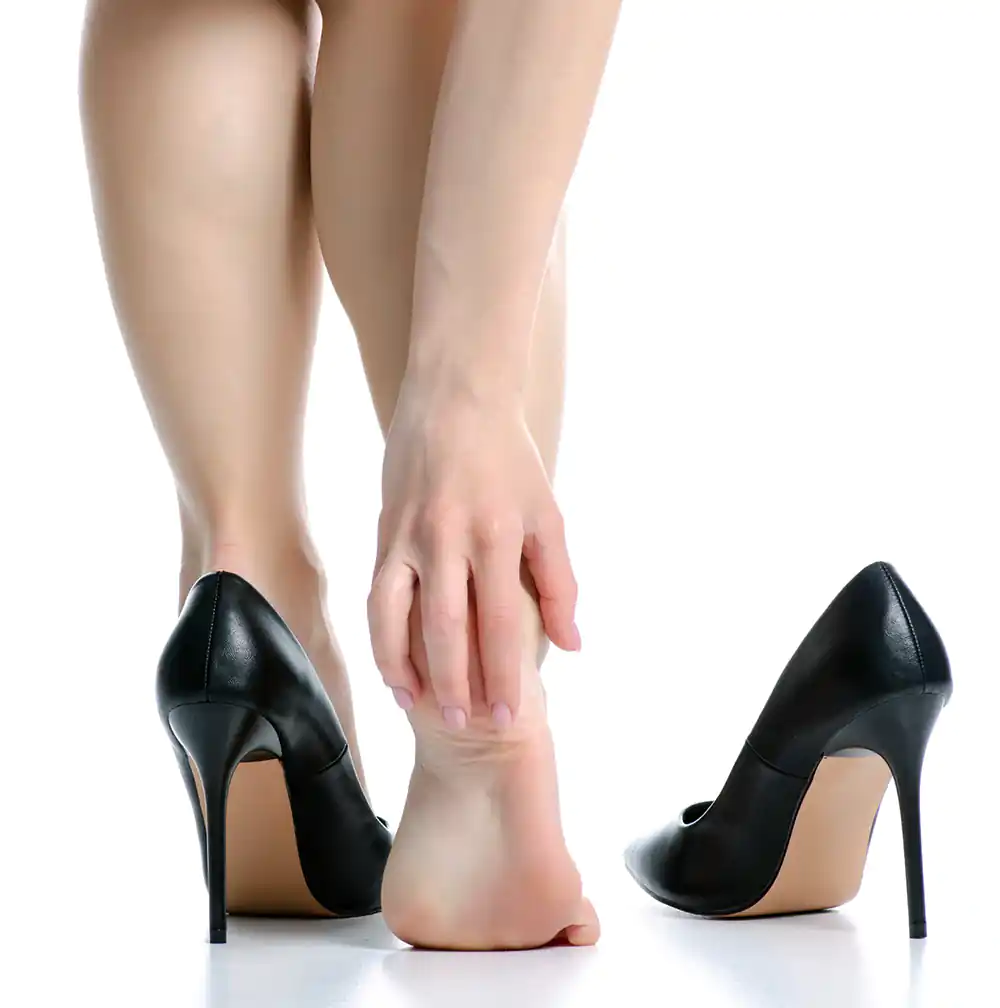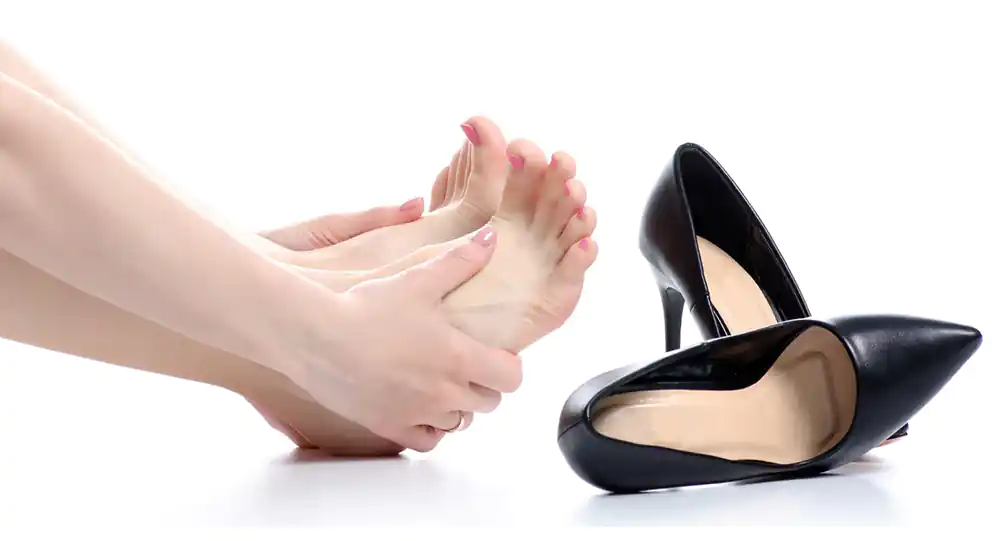High heels are undoubtedly one of the most glamorous fashion accessories that can enhance the elegance and grace of a woman’s attire. They make the legs look longer, accentuate the calves, and add an air of confidence to the overall appearance. However, while high heels can make a statement, they also come with a price. The long-term effects of high heels are not limited to sore feet and aching ankles. In fact, there are several disadvantages associated with wearing high heels that can lead to serious health issues.
While many women may be willing to bear the discomfort of wearing high heels, it’s important to be aware of the potential risks and take steps to prevent any long-term damage.
In this article, I will explore the various disadvantages of wearing high heels and give some tips on how to wear them safely. So, if you’re a fan of high heels, keep reading to find out more about the risks associated with this fashionable footwear.
Disadvantages of wearing high heels
From ankle injuries to knee pain and from back problems to postural issues, the list of adverse effects caused by wearing high heels is extensive. It’s no secret that high heels alter the body’s natural posture, causing the center of gravity to shift forward. This unnatural posture can lead to various health issues, including chronic pain and even long-term damage to the feet, ankles, and spine. So, here is the list of disadvantages of wearing high heels.
Foot pain
One of the disadvantages of wearing high heels is foot pain. High heels alter the natural position of your foot, forcing your toes into a cramped and unnatural position.
This can lead to discomfort and pain in the ball of the foot, the arch, and the toes. The pressure on the feet can also cause blisters, calluses, and corns.
Additionally, high heels can cause a strain on the Achilles tendon and the calf muscles, which can lead to tightness and pain. Overall, wearing high heels can cause significant discomfort and pain in the feet, which can make it difficult to walk or stand for extended periods.

Ankle injuries
Wearing high heels can increase the risk of ankle injuries. This is because high heels can destabilize the ankle joint, making it more prone to twists or sprains.
When you wear high heels, your feet are forced into an unnatural position, which puts extra pressure on the ankle joint. If you lose your balance or step on an uneven surface, it’s easy to roll your ankle and cause an injury.
Ankle injuries can be painful and take a long time to heal, affecting your mobility and quality of life. Therefore, it’s important to be careful when wearing high heels and avoid wearing them for extended periods.
Knee pain
Knee pain is another disadvantage of wearing high heels. Wearing high heels can change the alignment of the knee joint, which can put excess pressure on the knee and cause pain. This can lead to inflammation and swelling of the knee joint, which can be quite painful.
Over time, this can cause more serious knee problems such as osteoarthritis. Knee pain can also cause difficulty in walking, which can further aggravate the problem.
To prevent knee pain, it is recommended to wear comfortable shoes with good support and avoid wearing high heels for long periods of time.
Back pain
Wearing high heels can also cause back pain. This is because high heels affect the posture and alignment of the spine, leading to muscle tension and strain.
When wearing high heels, the pelvis is pushed forward, the lower back arches excessively, and the upper body leans forward. This position can put pressure on the lower back, causing pain and discomfort. The higher the heels, the greater the strain on the back muscles.
Wearing high heels regularly can lead to long-term back problems, such as herniated discs or chronic pain. It is important to wear comfortable shoes with good arch support to prevent back pain.
Posture problems
Wearing high heels can negatively affect your posture. When you wear high heels, your body weight shifts forward, causing you to arch your back to compensate for the imbalance.
This position puts a lot of strain on your lower back and can cause pain and discomfort over time. Additionally, wearing high heels for prolonged periods can lead to muscle imbalances and changes in the natural curve of your spine, affecting your overall posture.
Poor posture can lead to a range of health problems, including back and neck pain, headaches, and even digestive issues. It’s important to be aware of the potential posture problems associated with high heel wear and to take steps to minimize the risk of these issues.
Long-term damage
Wearing high heels for a prolonged period can cause long-term damage to the feet, legs, and spine. The unnatural position of the feet in high heels places excessive pressure on the joints and can lead to conditions like arthritis and joint pain.
In addition, wearing heels can cause the calf muscles to shorten, which can affect the ankle’s range of motion and increase the risk of injuries. Wearing high heels also changes the alignment of the spine and can cause lower back pain over time.
Over time, the combination of all these factors can lead to chronic pain, posture problems, and long-term damage to the body.
Crooked feet
Wearing high heels for extended periods can shorten the Achilles tendon, causing a person’s feet to become permanently bent or twisted. This can cause the foot’s muscles and tendons to adapt and shorten, causing the arch of the foot to collapse and resulting in crooked feet.
Crooked feet can cause an array of problems, including corns, calluses, and bunions. It can also make it difficult to wear other shoes and limit a person’s ability to perform certain physical activities such as running or jumping.
Therefore, it is essential to limit the use of high heels and alternate them with flat or low-heeled shoes to avoid crooked feet and related problems.
Hyperextension in toes
Wearing high heels can lead to hyperextension of the toes, which means that the toes are bent upwards excessively, causing pressure on the ball of the foot. This can lead to pain, discomfort, and even long-term damage.
High heels shift the body’s weight onto the front of the feet, causing the toes to bear the body’s weight. Over time, this can cause the tendons and ligaments in the feet to become weak, leading to pain and discomfort.
Additionally, this can cause the toes to become permanently bent or deformed. Hyperextension of the toes is a common problem that can occur when wearing high heels for an extended period of time.

Limited mobility
Wearing high heels can lead to limited mobility due to the altered foot and ankle position. High heels cause the calf muscles to shorten and tighten, which can affect the flexibility of the ankle and limit the range of motion.
This can cause difficulty in walking, running, or even standing for long periods of time. Over time, limited mobility can result in muscle imbalances, joint stiffness, and even chronic pain in the foot, ankle, and leg.
Therefore, it’s essential to wear shoes that allow natural movement of the feet and avoid wearing high heels for extended periods to prevent the development of limited mobility.
What happens if you only wear high heels everyday?
Wearing high heels daily can harm your body, particularly your feet, ankles, calves, knees, and back. These shoes can cause discomfort, pain, and even deformity and injury. High heels can also lead to a shortened Achilles tendon, which can cause conditions like plantar fasciitis and Achilles tendonitis. Additionally, high heels can aggravate a deformity known as Haglund’s, a bony enlargement on the back of the heel.
Wearing high heels regularly can limit your mobility, making you more prone to injuries. It can also result in permanent damage to your feet due to the unnatural distribution of weight it creates. Wearing high heels for extended periods can displace the natural fat pad in the ball of the foot towards the toes, which reduces shock absorption and can cause joint inflammation.
Opting for lower heels with proper support is recommended to minimize the negative effects of wearing high heels daily. Wearing orthotic inserts or arch supports can also provide relief. Limiting the duration of time spent in high heels and taking breaks throughout the day to stretch your feet and legs is advised. By taking these precautions, you can avoid the hazards of wearing high heels regularly.
What is the recommended height for high heels to avoid health problems?
To avoid health problems caused by wearing high heels, experts recommend choosing heels with a height of three inches or less. Wearing higher heels increases pressure on the balls of your feet, throwing off your center of gravity and putting unnecessary stress on your body.
Varying heel height is also recommended, with a medium-height wedge being best for low-arch or flat feet, while a short stiletto should be fine for high-arched feet. A 2-3 inch wedge with a comfortable back is the best heel for daily wear.
Choosing shoes with moderate heel height, no higher than five centimeters, and a fastening over the instep is important to provide adequate support. Wearing shoes with a one-inch heel or wedge height, rather than completely flat shoes, can place less tension on the Achilles tendon and make it feel more comfortable.
It’s also advised to avoid completely flat shoes as they can contribute to pronation and arch collapse. By following these guidelines, you can minimize the negative effects of high heels on your health and still enjoy wearing them.
Summary
High heels are a fashion statement for many women, but they come with a host of disadvantages. The most obvious is foot pain, which is caused by the unnatural position of the foot in a high heel. Ankle injuries are also common due to the instability of the shoe, and knee pain can result from the added pressure on the joints.
Back pain is another disadvantage, as high heels can cause the spine to become misaligned. Posture problems can also occur as the body tries to compensate for the unnatural angle of the foot.
Long-term damage can result from wearing high heels too often, and limited mobility can be a problem. In addition, high heels can cause the feet to become crooked and can lead to hyperextension in the toes.
Overall, while high heels may look great, they are not the healthiest option for footwear. It’s important to consider the potential drawbacks before wearing high heels regularly.
FAQ
What is the high heel syndrome?
High heel syndrome is a term used to describe high heels’ impact on the feet and body. It refers to the anatomical changes that can occur in the legs due to the overuse of high heels. These changes can include shorter calf-muscle fibers and thicker, stiffer Achilles tendons, which can cause the ankle joint to have a smaller range of motion and make flat shoes less comfortable.
What arthritis is caused by high heels?
Wearing high heels can cause knee osteoarthritis, which is more common in women than men. However, there is no specific arthritis that is caused by high heels.
Which type of heels are most comfortable?
The most comfortable types of heels are those chunky or block heels, kitten heels, platform heels, and wedge heels.
What are the easiest heels to walk in?
Wedge heels are generally considered the easiest heels to walk in, as they have a larger surface area and provide more stability than stilettos. Block heels are also a good option for comfortable and easy-to-walk-in heels.
Should you walk heel first or toe first?
It is recommended to walk heel first for efficient walking and to conserve energy. Walking on the balls of your feet or toes can use up to 53% more energy than walking heel first.



